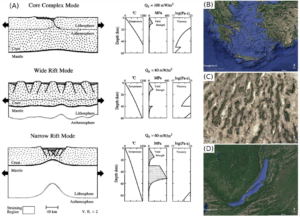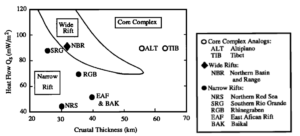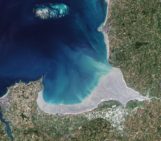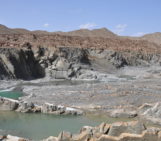
Buck (1991) aims at solving the intense ‘70s and ‘80s tectonic debate concerning the way extension is accommodated in continental regions (see our previous blog posts here and here). His article explores the physical conditions that can lead to the three end-member modes of lithospheric extension in continents: core complex mode, wide rift mode and narrow rift mode. The three extensional modes that Buck identifies have specific characteristics. Core complex mode is characterized by localized upper crustal extension with (i) thinning of a weak lower crust over a large area and (ii) mantle lithosphere extending in a local area. Wide rift mode is marked by uniform crustal and mantle lithospheric thinning over a large area broader than the thickness of the lithosphere. Narrow rift mode presents focused crustal and mantle lithospheric extension (Fig. 1A).
In this 1991 must-read article, Roger Buck explores continental extension by means of numerical modelling. He brings numerical constraints on how thick the crust and the lithosphere should be to obtain a certain setting, and which heat flow and overall rheology of continental crust and mantle is needed to obtain each of the three modes of rifting. The paper first describes the models geometrical set up, thermal calculation and yield strength, while making general considerations on buoyancy forces acting during extension of continental lithosphere. This section specifically discusses how the variation in crustal thickness during rifting produces differences in the lateral pressure in the crust. This is important, because the pressure gradient drives the flow of the hot and weak lower portion of the crust.

Fig. 1. (A) sketches of the lithosphere with the three modes of continental extension. The plots to the right show particular initial model geotherms, yield strength and effective viscosities (dry quartz and dry olivine mantle) corresponding to each mode. From top to bottom crustal thickness decreases (50, 40, 30 km). Qs is the initial surface heat flow. Right panels: Google Earth images with examples of core complexes (B – Aegean domain, Greece), wide rift (C – Basin and Range, USA), and narrow rift (D – Lake Baikal, Russia).
Buck (1991) underlines the importance of initial thermal state and crustal thickness in determining the mode of continental extension. The role of strain rate is important, and should be taken into account as well to understand natural examples of the different extension modes. However, the article highlights that the strain rate is not the dominant factor, as exemplified by the Northern Red Sea: given its very low strain rate, the analysis predicts a wide rift, which is not observed. Whereas the transition between narrow and wide rifting modes takes place at relatively constant temperatures for high strain rate, an increase in temperature is needed for lower strain rates (Fig. 2). Interestingly, Buck reminds that if strain rate is sufficiently low, the extension can increase the strength of a rift and in turn lead to rift abandonment, as the strength of the lithosphere increases by replacing crustal material by stronger mantle rocks (Kusznir and Park, 1987). The model presented in the article is simplified and further exploration of the concepts through more sophisticated numerical models for larger strain have been considered in the recent past (see e.g. Gueydan et al., 2008).

Fig. 2. Mode boundaries in crustal thickness versus Moho temperature (TM) space for dry quartz crustal theology for an extensional strain rate of 8 x 1015 s-1 with heat sources with data for several areas of extension.
Buck (1991) calls for caution in making inferences from a specific tectonic setting to features of other extending regions and encourages looking for field case-studies of the three modes in the geological record. In particular, the temporal progression between different modes appears of interest, as proposed in extensional systems developing above rollbacking subduction slabs (e.g. Brun et al 2016). Considerations from plate kinematics and geodynamic models are fundamental to determine the role of extension velocities and initial thermal state in the resulting structural pattern of extensional regions.
Gianluca Frasca, Benoît Petri, David Fernández-Blanco and the TS Must Read team
References
Brun, J.-P., Faccenna, C., Gueydan, F., Sokoutis, D., Philippon, M., Kydonakis, K., & Gorini, C. (2016). The two-stage Aegean extension, from localized to distributed, result of slab rollback acceleration. Canadian Journal of Earth Sciences, 53(11), 1142–1157
Buck, W. R. (1991). Modes of continental lithospheric extension. Journal of Geophysical Research: Solid Earth, 96(B12), 20161–20178
Gueydan, F., Morency, C., & Brun, J.-P. (2008). Continental rifting as a function of lithosphere mantle strength. Tectonophysics, 460(1), 83–93. https://doi.org/10.1016/j.tecto.2008.08.012
Kusznir, N. J., & Park, R. G. (1987). The extensional strength of the continental lithosphere: its dependence on geothermal gradient, and crustal composition and thickness. Geological Society, London, Special Publications, 28(1), 35–52.



